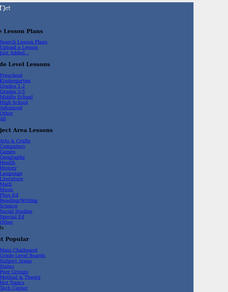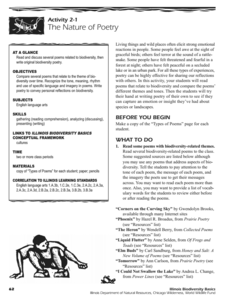Curated OER
What is it...A Frog or a Toad?
Learners write a story. In this frogs and toads comparison instructional activity, students read facts comparing frogs and toads, use a t-chart to record factual information and complete a Venn Diagram. Learners complete a four square...
Curated OER
Frog and Toad Are Confusing
Third graders are introduced to the similiarties and differences between a frog and a toad. In groups, they compare and contrast them and identify distinguishing characteristics of each. They watch a video on the animals and answer...
Curated OER
Frogs and Toads Are Different
Second graders identify the unique characteristics of frogs and toads. Through Internet research and reading the book Frog and Toad are Friends by Arnold Lobel, 2nd graders compare and contrast the two amphibians.
Curated OER
Frog Or Toad?
In this expository comprehension worksheet, students read a 1-page informational article about frogs and toads, answer short answer questions, and fill out a Venn diagram to compare the two amphibians.
National Science Teachers Association
Hop into Action
Young scientists find out what makes amphibians such unique and interesting animals in this simple life science lesson. After looking at pictures and discussing the characteristics of amphibians, learners complete a series of three Venn...
Curated OER
Graphing Toad/ Frog Respiration
Students measure respiratory rates on live toads, and the effect water temperature has on their findings. In this scientific method lesson, students record their findings and present them in a graph, comparing the results.
Curated OER
Animals attributes
First graders analyze different animals in fiction and nonfiction stories. In this animal lesson plan, 1st graders choose an animal and read a fiction story with that animal as a character. They describe how the animal acted in the story...
Curated OER
Holy Habitats or Meet Metamorphosis
Students examine the metamorphosis of frogs and how it adapts to its environment. They research how world pollutants are effecting the amphibian population.
Curated OER
Learning Activities: Magic Words
Students use poetry to compare and contrast humans and frogs.
Omaha Zoo
Monitoring Amphibians
What sort of shoes do frogs wear? Open toad sandals. If your scholars want experience collecting field samples, this is the lesson for you. After learning the proper way to collect field samples, pupils catch amphibians to test for...
Curated OER
Marshland Wonders
Students review the characteristics of wetlands and list their benefits. After viewing short videos, they identify the organims that make their home in wetlands and how they have adapted. They compare and contrast the characteristics...
Curated OER
Investigation 12 - Amphibians & Reptiles
Fourth graders compare and contrast the behavior and structure of amphibians and reptiles of Utah. The Division of Wildlife Resources website is an important resource for them to access, for information as well as colorful pictures of...
Illinois Department of Natural Resources
Section Two: Why is Biodiversity Important?
Explore soil, genetic traits, natural resources, and pollution in a series of lessons that focus on biodiversity. Kids complete experiments to learn more about the importance of varied genes and organisms in an ecosystem.
Curated OER
A Moth Is Not a Butterfly!
Students identify the differences and similarities between a butterfly and a moth. They complete a Venn diagram, participate in class discussion and conduct related Internet research on the topic.















